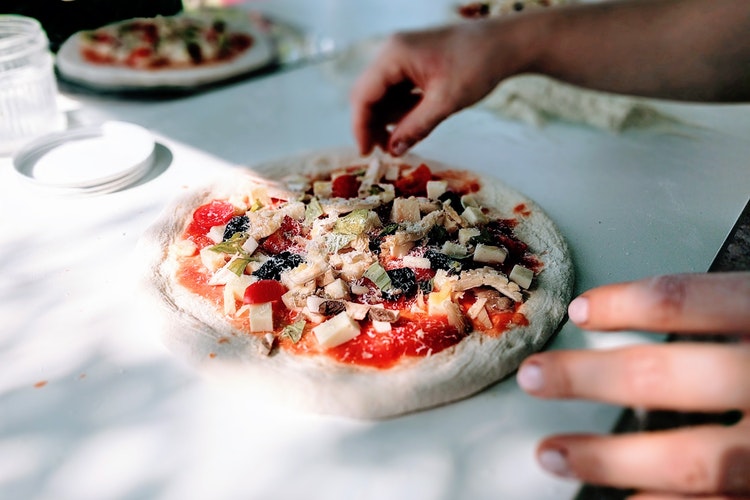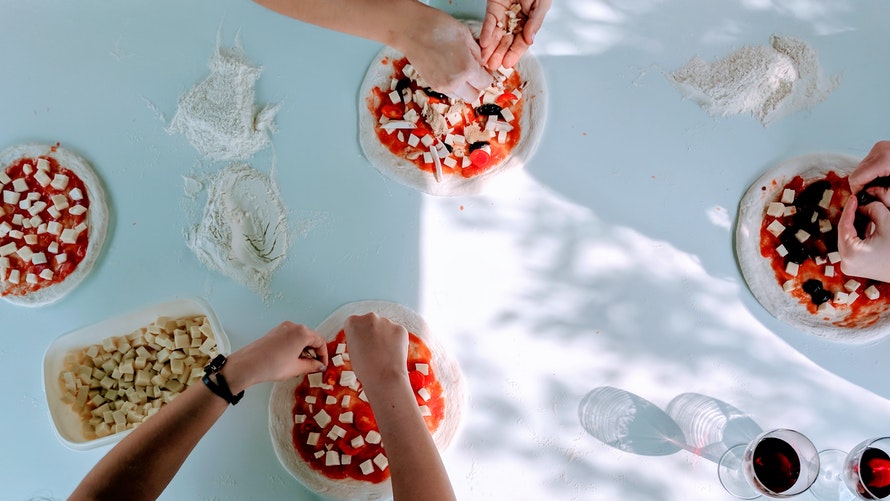A little dough, a ladleful of sauce and a sprinkle of cheese… No dish in the world manages to coax pure ambrosia from so few ingredients as pizza.
Even the word ‘pizza’ evokes an image that gets this writer salivating, Pavlov dog-style, and judging by the mess that you’ve made on your keyboard, might we assume you’re the same?
But don’t reach for the Deliveroo takeaway pizza just yet. Nope, here at IDEAL, we prefer to be covered in a dusting of flour, splatters of passata, with mozzarella under our fingernails and ricotta in our hair (and that’s not just our bedroom preferences).
So, with that in mind, here are our 7 beginner’s tips for making the best homemade pizza.
Make Your Own Dough
Making your own dough is the backbone of a great homemade pizza; those ready-made cardboard bases tend to go from soggy to blackened snap in no time and are best avoided.
Fortunately, constructing your own base involves just a few ingredients and can be a lot of fun (and a good workout, too!).
You’ll only need some strong double zero flour, fresh (or dried if that’s all that’s available) yeast, warm water, olive oil, salt, and perhaps a sprinkle of sugar. Mix the dry ingredients, knead with the wet ones and let sit for two hours in a bowl in a warm place.
Then, knock it back, knead again, divide into individual pieces and leave to rise again, covered with a dry tea towel for about an hour. After this time, you’re ready to roll (or stretch, but more of that later).
Check out this guide on how to make pizza dough from Great Italian Chefs for a detailed breakdown of measurements and method.
A Simple Tomato Sauce
This article said homemade, so homemade it is, and no corners are to be cut. Making a simple tomato sauce is as easy as pizza-pie. Of course, there is no one recipe which trumps all others, and Nonnas across Italy will forever debate which is the finest fervently, but a good start involves minced garlic cooked off in olive oil, tomatoes (both fresh and tinned have their merits) and dried oregano.
Other notable additions include a pinch of sugar, a few dried chilli flakes, or, perhaps a splash of balsamic vinegar, should the balance of your tomatoes not be quite right. After simmering gently for an extended period, blitz until smooth if you prefer it that way. Otherwise, a little rough, ready and rugged is great, too. And don’t forget to season.
Alternatively, if you have access to some seriously good fresh San Marzano tomatoes, (in the UK, the premium tinned tomato brand Mutti does very serviceable San Marzano D.O.P in cans), then do as the Neapolitans do, and use your hands for a delicious no cook, no utensil sauce! Simply squeeze some tomatoes over a bowl until they are pulped, and mix with a little olive oil, salt and pepper. They also sell tins of ‘pizza sauce‘ made from 100% Italian sun-ripened tomatoes blended with basil, oregano, and onion which are perfectly good.

Stretch Or Roll, It’s Your Call
Although pizza purists will insist on tossing and stretching, consider your skill set before you enter into such acrobatics (and histrionics in the home setting, perhaps).
If you can toss like a pro, then great, but if you’re afraid of your carefully, lovingly made pizza dough ending up on the ceiling, then there’s no shame in using a rolling pin to find the desired shape. Just remember to flour your surface and pin to avoid tearing.
Depending on the type of oven, tray, pizza stone and even pizza peel you’re using, you may want to assemble your pizza either on the tray or on the peel.
Apply Toppings Sparingly
The words meat feast and a list of every edible animal should not be anywhere near a pizza menu. Toppings should be used sparingly – no more than three or four is ideal – and should be chosen to work in harmony.
We love butternut squash, goat’s cheese and rosemary, or simply anchovies, olives and capers. Keep it light, simple and harmonious. Oh, and remember; not all pizzas demand a tomato base – pairing the flavours should extend to whether or not you include a sauce, with white pizzas equally delicious when in the right hands.
Read: 9 of the best London pizza restaurants for 2022
The All-important Oven
How you top and cook your pizza will be determined by the type of oven you’re using. In an ideal world (and that’s why you’re here, right?), you would have a wood fired pizza oven in your kitchen, pizzeria style, though this requires huge amounts of space, attention, and excessive heat for the domestic seating.
Fortunately, in recent years, mini versions designed for personal use have come on the market, with the wood fired pizza oven from Ooni arguably the most popular. Simple to set up in the garden and able to reach 500°C in just 15 minutes, this is the best way to get that Neapolitan effect of blistered crust and a surprisingly light finish on your dough.
A few other options exist, including using a pizza stone in a normal fan or gas oven, or even on a barbecue. Pizza stones work by mimicking the style of a hot brick oven, holding high heat and absorbing moisture for a crisp, burnished base. Simply pre-heat for ten minutes or so, and slide your pizza on.
You can also do the same using a perforated pizza tray, with the holes allowing for better air circulation, which deters the base from getting soggy. If you’re using one, be careful not to top your pizza excessively, or it could lead to a structural collapse.
Finally, there is the frying pan pizza method, which allows you to get the requisite high temperatures to cook the base until blistered on your hob. Cast iron pans are best here, as they conduct and retain heat most capably.

Finish With Fresh Herbs & Olive Oil
After the pizza comes out of the oven, there are still a couple of loving additions that will elevate it from good to great. Fresh herbs like basil should be added here, as the heat of the oven would have somewhat dulled their vibrancy. Adding a dash of olive oil brings a wonderful mouthfeel and freshly cracked black pepper seals the deal.
What To Drink With Pizza
As Fiona Beckett at Matching Food and Wine recommends, Italian reds which are ”moderate in alcohol and with the fresh acidity to cut through gooey cheese and tomato toppings” are best here. She recommends Chianti, Barbera, a Valpolicella or a Rosso di Montalcino. White wine is better deployed if you’ve made a white pizza – that is, a pizza with no tomatoes and generally more cheese, with ricotta commonly used.
Alternatively, a crisp, refreshing lager such as Peroni Nastro Azzurro or everyone’s favourite soft drink, San Pellegrino Limonata, work well with pizza.
Happy cooking everyone!
Now, for something very different, allow us to whisk you off to Thailand, for our favourite pizza places in Bangkok. Buon Viaggio!





